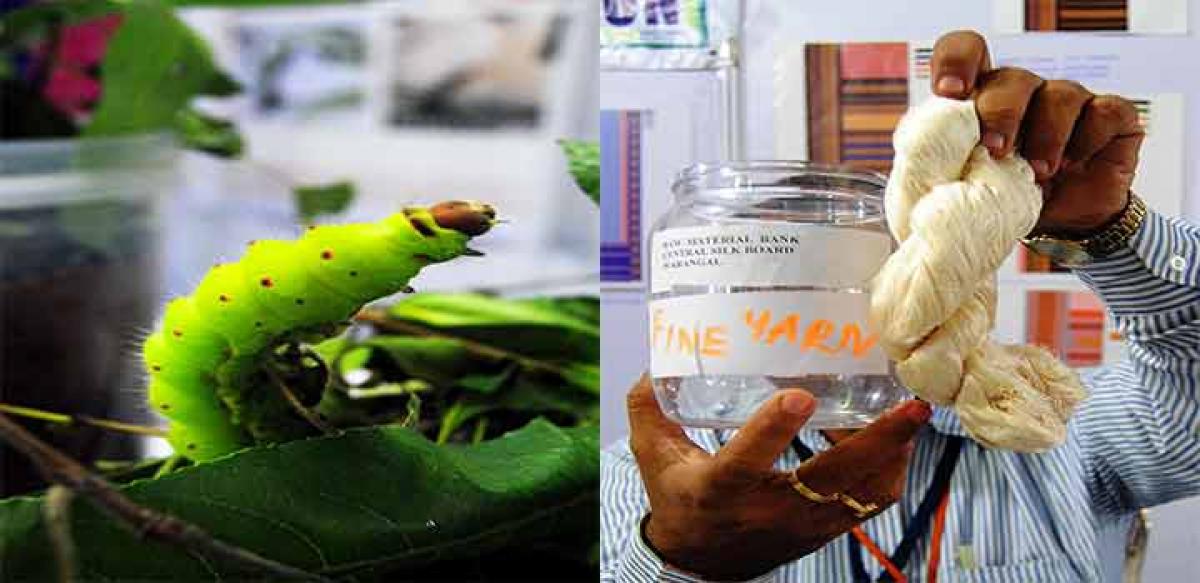Live
- Space Station Safety Alert: Toxic Smell Detected After Russian Cargo Docking
- Protests in Tripura against Hindu priest's arrest in Bangladesh
- Sambhal miscreants being identified through CCTV, will face strict action: UP Minister
- Sambhal violence: Police release photos of rioters including three women
- AI-Enhanced HR Co-Pilot Max Sara 2.0 Rolled Out
- Hyderabad SBI Branch Prevents Senior Citizen from Falling Victim to Rs 13 Lakh Scam
- Maharashtra CM Post: Eknath Shinde's Plan B
- IPO-bound Senores Pharma, Dr. Reddy's Labs launch ivermectin tablets in US
- PAN 2.0: What is PAN 2.0, Benefits, Impact on Business and How to Apply
- Air India optimises key domestic metro routes post Vistara merger
Just In

Silk is one of the on-going fads, and it comes from a natural process. The fabric gives an elegant and fashionable look for any occasion.

Transformation of tiny silkworms into a beautiful fabric
Silk is one of the on-going fads, and it comes from a natural process. The fabric gives an elegant and fashionable look for any occasion.
It’s one of woman’s most preferred materials used in India, as it’s pure, comfortable and it is stylish to wear. The most interesting part is that eventhough it is produced by several live insects, but generally only the silk of moth caterpillars is used for textile manufacturing.
The process of making silk is very fascinating. Observing and watching the process of how worms are converted to a fabric is really breathtaking.
People have always been curious about the procedure of making silk, and recently different kinds of silkworms and the process of making various kinds of silk was demonstrated at Silk Mark Expo in Hyderabad.
A few well-known species of the silkworms are Mulberry, Eri and Tussar. Mulberry and Eri are domesticated silkworms and Tussar is a wild silkworm.
Mulberry Silk
Baby silkworms are fed mulberry leaves three times in a day. They increase in length by more than 40 times ie three inches. And within 15-20 days of their feeding time, they shed their skin four times in the process.
Subsequently, when the silkworms are ready to spin, they are kept in a container and are covered in a cloth to protect them from flies. When the worms are completely transformed into cocoons, they are put in boiling water.
Then the filaments from most of the cocoons are reeled together on a wooden spindle into a uniform strand of raw silk.
Eri Silk
The Eri caterpillars eat a number of plants. They grow in most of the Indian states. Heavy rainfall and humid weather suits the Eri culture. The spun threads are mostly cottony although some Eri yarns are soft and shiny. After 30-32 days, the silkworms creep in search of comfortable place among the leaves to spin their cocoons.
Tussar Silk
The growth of the worms takes place in a forest or wild environment. It’s a wild variety Tussar. There are five stages of Tussar silk production. Egg-Larva- Pupa-imago-moth. Terminalia Arjuna is the wild plant used for the growth of the silkworm. After mating, female lays eggs.
It takes 8 to 10 days to hatch into a worm. Then these worms are kept on the wild plants and after four to five days, depending on the climate , the growth takes place. If the weather is warm the growth happens faster. Then the cocoon is heated.
There are number of varieties of silk that are created in this process like bivoltine variety, pierced cocoon, etc. After the process, the silk yarn is used to weave sarees, dress materials, shirts and accessories too.
When asked how to recognise whether the silk material is pure or not Ravi, who demonstrated Tussar silk manufacturing process said, “When we burn silk material we get pungent smell and a lump is collected immediately - this is one of the techniques, which proves that the material is pure.”
By:Chitra Saikumar

© 2024 Hyderabad Media House Limited/The Hans India. All rights reserved. Powered by hocalwire.com







